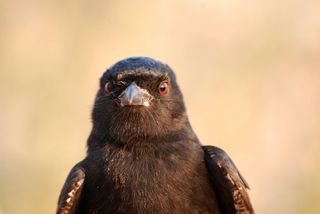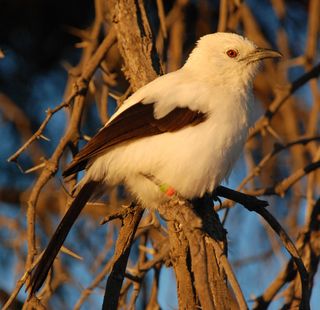Sly Birds Cleverly 'Cry Wolf' to Steal Food

The red-eyed, black-feathered fork-tailed drongo is an irrepressible mimic, capable of reproducing the calls of everything from other birds to mongoose-like meerkats. Now, a new study finds that these drongo birds are strategic copycats: They "cry wolf" about potential danger, startling other animals and stealing their food.
What's more, drongos (Dicrurus adsimilis) alter their cries to keep their targets from becoming inured to the trick.
This ability to change up calls when one of the calls isn't working may be an evolutionary way to get around the problem the little boy in Aesop's fable ran into: If you raise the alarm about danger too many times, eventually, no one listens. The problem plagues any animal that uses a deceptive strategy, said study researcher Tom Flower, a behavioral ecologist at the Percy FitzPatrick Institute of African Ornithology.
"Drongos, by varying the type of alarm call they make when they're making repeated food-theft attempts, actually maintain the deception," Flower told Live Science.
False alarms

Flower studied drongos in the Kalahari Desert of South Africa. At the desert's Kuruman River Reserve — where the popular Animal Planet show "Meerkat Manor" was filmed — animals are habituated to human presence. They're also tagged with specks of dye (for meerkats) or ankle bands (for birds). This allows researchers to make close observations of specific individuals.
At the site, Flower said he "spent a long time walking around with the meerkats, and the drongos commonly came over and joined us." He noticed the birds treated the meerkats like living "plows." As the meerkats dug up dirt, the drongos would trail the mammals, catching bugs churned up by their paws.
Sign up for the Live Science daily newsletter now
Get the world’s most fascinating discoveries delivered straight to your inbox.
Intriguingly, when a meerkat came across a particularly delicious snack, such as a scorpion or fat larva, the drongos would sometimes let loose with an alarm call. Sometimes the call would mimic that of the meerkat or another species, and sometimes it would be a drongo cry. This would typically spook the meerkat, making it drop the tasty morsel and retreat, at which point the drongo was free to swoop in for a free meal.
Drongo deception
To understand this behavior, as well as the dazzling array of alarm calls drongos can mimic (Flower recorded one individual with a range of 32 different calls), Flower and his team recorded 688 food-theft attempts over almost 850 hours of observations. The scientists found the drongos did tailor their calls, generally mimicking the alarm call of the animal they were trying to trick.

Next, the researchers played recorded drongo calls for captive southern pied babblers (Turdoides bicolor), white-and-brown birds frequently targeted by drongo deception. Two calls were drongo calls; one was a drongo mimicking a pied babbler alarm call, and one was a drongo mimicking a starling alarm call.
The pied babblers responded more strongly to fake starling and pied babbler calls than to drongo alarm calls, suggesting that taking on the voices of others benefits the drongos. In a follow-up experiment, the researchers again played various drongo calls to pied babblers. This time, they either played the same calls three times in a row or played two of the same calls followed by a third, different call.
Sure enough, the pied babblers began ignoring repeated alarms of the same sort, seeming to realize that the caller was crying wolf. When the call switched, though, the birds continued to fall for the trick.
Smart strategy
In the wild, Flower found, drongos use this switch-'em-up strategy. He observed 151 occasions of repeated food theft by 42 drongos, and found the birds switched up their calls about 75 percent of the time. They were even more likely to do so if the previous theft attempt had failed, Flower and his colleagues report today (May 1) in the journal Science.
"They actually attend to feedback from their listeners' behavior and adjust their alarm calls accordingly," Flower said. [The 5 Smartest Non-Primates on the Planet]
This talent may seem eerily clever, and it's possible it indicates drongos have a talent known as theory of mind, or the ability to understand what others might be thinking. But although the question of whether animals have such a theory of mind is a hot one, Flower said drongos don't need to know what their targets are thinking.
"It could be a really simple rule of thumb," he said. The birds might simply use what works: If a call succeeds, they repeat it. If it doesn't, they switch it up.
The fact that a learned behavior, rather than humanlike cognition, might be behind the ability does not make it less exciting, Flower said.
"What it says is that you can accomplish incredibly sophisticated behaviors through simple mechanisms," he said. "And that begs the question, 'What is the evolutionary benefit to more complicated mechanisms like theory of mind?'"
Answering that question, he said, might explain what makes humans (and chimpanzees) so unusual in their abilities to understand others.
Follow Stephanie Pappas on Twitter and Google+. Follow us @livescience, Facebook & Google+. Original article on Live Science.

Stephanie Pappas is a contributing writer for Live Science, covering topics ranging from geoscience to archaeology to the human brain and behavior. She was previously a senior writer for Live Science but is now a freelancer based in Denver, Colorado, and regularly contributes to Scientific American and The Monitor, the monthly magazine of the American Psychological Association. Stephanie received a bachelor's degree in psychology from the University of South Carolina and a graduate certificate in science communication from the University of California, Santa Cruz.
